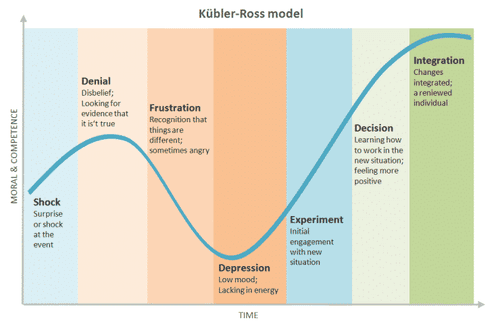Understanding the Kubler-Ross Change Curve
Curated from: cleverism.com
Ideas, facts & insights covering these topics:
7 ideas
·2.35K reads
5
Explore the World's Best Ideas
Join today and uncover 100+ curated journeys from 50+ topics. Unlock access to our mobile app with extensive features.
Change is inevitable
If a change is well planned, it can produce positive results. However, without planning, change can be hard to accept and appreciate.
The Kubler-Ross Model is the most reliable tool to understand change and the stages associated with it.
165
368 reads
The Kubler-Ross Model
The Kubler-Ross Model, also known as the five stages of grief, consists of the various levels of emotions that are experienced when facing trauma. The five stages are denial, anger, bargaining, depression, and acceptance.
After the model was widely accepted, it was found to be valid in a majority of cases and situations related to change.
198
356 reads
Relevance in Business
The Kubler-Ross Change Curve is also true when it comes to business, work, or employment.
Change can cause a lot of upheaval to the employees. If there are improvements to be made in systems and policies, the employees can't persist in their old ways. Only when the employees of an organization make personal change, can the company move ahead to reap the benefits.
163
433 reads
The 5 stages of grief
- Denial: Shock or denial mark this stage and is usually short-lived. One may not believe what is happening.
- Anger: When the realization hits and is understood, a person may become angry and look for a scapegoat.
- Bargaining: When the anger subsides, one may start thinking about ways to postpone the inevitable and look for the best thing in the situation.
- Depression: The person feels sadness, fear, regret, and guilt. They may reach a dead end where the road seems hopeless.
- Acceptance: This is when people resign to the situation. It may not be a comfortable space, but the person may now move ahead with it.
206
307 reads
The Change Curve in business
A reliable tool to understand what people are going through.
- Stage 1: The employee will be in shock. They may need time to adjust.
- Stage 2: When the gravity of the situation settles in, workers may feel fear from what lies ahead, which may turn to anger and resentment. Clear communication and support should remain the focus at this level.
- Stage 3: When employees understand that they must adapt, they may try to bargain with management, or learn as little as possible to adapt. Don't rush employees to learn quickly or adjust fast.
- Stage 4: The learning phase may be uncomfortable for employees and could result in low energies due to low morale.
- Stage 5: People finally start to embrace the change and start building new hopes and aspirations.
169
222 reads
The ADKAR Model
It demonstrates five ingredients needed for change.
- Awareness: Awareness helps one understand why change is important and needed.
- Desire: The desire to be a part of the change.
- Knowledge: The desire is incomplete without knowing how change can be brought about.
- Ability: All can be in vain if the individual does not have the ability to grow with it.
- Reinforcement: This building block sustains the change.
208
294 reads
Change management strategy
- Create: Establish a feeling of urgency or hurriedness towards change.
- Build: Formulate a guiding coalition.
- Form: Develop a strategy to bring about change. This requires having a plan and a vision.
- Enlist: One must now communicate or put forth the vision or strategy for change.
- Enable: Empower the employees to incorporate the changes.
- Generate: Formulate short-term goals and achieve them.
- Sustain: Capitalization of wins or gains in order to produce bigger results.
- Institute: Finally, incorporate new and better changes in the workplace culture.
196
372 reads
IDEAS CURATED BY
Connor H.'s ideas are part of this journey:
Learn more about personaldevelopment with this collection
Identifying and eliminating unnecessary expenses
How to negotiate better deals
Understanding the importance of saving
Related collections
Similar ideas
20 ideas
The Stages of Grief: How to Understand Your Feelings
healthline.com
9 ideas
The 5 Stages of Grief
psychcentral.com
8 ideas
The Psychology of Self-Deception - Ego Defence 1 of 10: Denial
psychologytoday.com
Read & Learn
20x Faster
without
deepstash
with
deepstash
with
deepstash
Personalized microlearning
—
100+ Learning Journeys
—
Access to 200,000+ ideas
—
Access to the mobile app
—
Unlimited idea saving
—
—
Unlimited history
—
—
Unlimited listening to ideas
—
—
Downloading & offline access
—
—
Supercharge your mind with one idea per day
Enter your email and spend 1 minute every day to learn something new.
I agree to receive email updates

